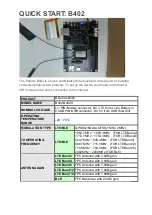
LinkIt 2523 HDK v11 User's Guide
© 2015 - 2016 MediaTek Inc.
Page 22 of 82
This document contains information that is proprietary to MediaTek Inc. (“MediaTek”) and/or its licensor(s).
Any unauthorized use, reproduction or disclosure of this document in whole or in part is strictly prohibited.
Table 10. LinkIt 2523 board’s eFuse jumper pin settings (illustrated)
Enable or disable
eFuse
Set the jumper J1102
with 0Ω resistor
to GND to disable the eFuse setting on the
HDK, as shown below.
Set the jumper J1102
with 0Ω resistor
to power rail VIO28 to enable the eFuse
setting on the HDK, as shown below.
4.6.2.
RTC source
The RTC source can be provided using either an internal or an external clock. Connect the jumper J1103 pin 2 and
pin 3 to provide 32.786kHz internal clock signal for BOM cost saving setting. Connect jumper J1103 pin 1 and pin 2
to select the clock source generated by external XTAL or built-in oscillator. Jumper J1104 should be synchronized
with the jumper J1103.
Set the jumper J1104 pins 1 and pin 2 to apply power saving mode, if 32.768kHz XTAL is mounted. Connect jumper
J1104 pins 2 and pin 3 for XTAL cost reduction. Table 11 provides details on how to configure the RTC jumper
settings for the HDK. The pin, jumper and resistor locations can be found in Figure 14.
Table 11. LinkIt 2523 board’s RTC jumper pin settings
Enable or disable
32.768kHz XTAL
Set the jumpers J1103 and J1104
with 0Ω resistors
to supply 32.768kHz clock by
XTAL, as shown below.
Set the jumpers J1103 and J1104
with 0Ω resistors
to supply 32.768kHz internal
clock, as shown below.
4.6.3.
Pins reserved for user-defined applications
The camera and sensor daughterboard pin headers can be configured in user-defined applications. In addition,
LinkIt 2523 HDK provides two sets of two-pin header jumpers for I2C, UART, EINT and GPIO pins that are software
configurable using the EPT (see Figure 19). Pin assignment tables to implement multi-mode selections can be
found in sections 4.16.1, “UART ” and 4.16.2, “I2C ”.
4.7.
LCM
The LinkIt 2523 HDK supports two types of display topology: MIPI DSI and serial. The MIPI interface provides a
maximum resolution of display of up to 320*320 pixels and it’s a hyper RGB 1.63 inch AMOLED display. The serial
1 2 3
1 2 3
















































